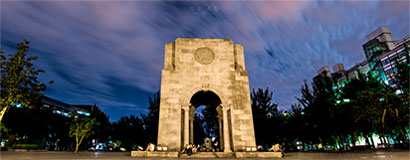Editor's Note: Recently, Prof. Hu Xiaolong’s group from the School of Precision Instrument and Optoelectronic Engineering collaborated with Prof. Yang Jingyu’s group at the School of Electrical and Information Engineering and demonstrated a non-line-of-sight (NLOS) imaging system that allows people to see objects hidden behind obstacles. They introduced a superconducting nanowire single-photon detector (SNSPD) as the detector in NLOS imaging system, which outperformed other single-photon detectors in terms of detection efficiency in the near- and mid-IR spectral ranges and made it possible for NLOS imaging to work at eye-safe bands. The research result was published in the Optica Publishing Group journal Optics Express and reported by the media Optica. Below is the new report from Optica Website. Click here for the original source.
Researchers extend non-line-of-sight imaging towards longer wavelengths
New system uses superconducting nanowire single-photon detector; could be useful for self-driving vehicles, robotic vision and more
NLOS imaging
WASHINGTON — Emerging technologies for non-line-of-sight imaging can detect objects even if they are around a corner or behind a wall. In new work, researchers use a new type of detector to extend this method from visible light into near and mid-infrared wavelengths, an advance that could be especially useful for unmanned vehicles, robotic vision, endoscopy and other applications.
“Infrared non-line-of-sight imaging can improve the safety and efficiency of unmanned vehicles by helping them detect and navigate around obstacles that are not directly visible,” said Xiaolong Hu from Tianjin University in China. His team collaborated with a group led by Jingyu Yang, also from Tianjin University. “Using near-infrared wavelengths could also help reduce eye safety concerns and lower the background noise, which could potentially allow imaging over longer distances during daytime.”
In the Optica Publishing Group journal Optics Express, the researchers describe the first demonstration of non-line-of-sight imaging using an advanced light-sensing component known as a superconducting nanowire single-photon detector. This detector exhibits single-photon sensitivity from x-ray to the mid-IR wavelengths, enabling researchers to extend the imaging technique’s spectral range to the near and mid-infrared wavelengths of 1560 and 1997 nm. The researchers also developed a new algorithm to further improve the images obtained by the system.
“This proof-of-principle demonstration opens doors for more research opportunities and potential applications,” said Hu. “Moving non-line-of-sight imaging toward the mid-infrared wavelengths brings advantages for many applications. In addition to improving navigation for robots and vehicles, it could also enhance the signal-to-noise ratio for biological imaging.”
Creating a sensitive eye
Non-line-of-sight imaging technologies use photodetectors to detect multiple rays of reflected light emitted or reflected from objects outside the line of sight. Unlike traditional line-of-sight imaging techniques such as LiDAR and photography, the light detected for non-line-of-sight imaging is very faint. This requires very high sensitivity detectors.
“We designed and made a superconducting nanowire single-photon detector that acts as a very sensitive eye for seeing an object hidden around a corner,” said Hu. “This detector outperforms other single-photon detectors in terms of detection efficiency in the near and mid-infrared spectral ranges, which made it possible to perform non-line-of-sight imaging at longer wavelengths.”
Superconducting nanowire single-photon detectors are based on the fact that a single photon will disrupt superconductivity. This creates a measurable change in electrical resistance that allows the detection of individual photons with high efficiency. In the new work, the researchers created a single-photon detector with 40-nm-wide nanowires arranged in a fractal pattern. This pattern, which exhibits similar shapes at various magnifications, makes it possible to effectively detect photons in all polarizations. The detector was cooled to ~2 K (just above absolute zero), which is required to achieve superconductivity.
Imaging in the infrared
After demonstrating that their superconducting nanowire single-photon detector exhibited better timing resolution and lower noise than an InGaAs/InP single-photon avalanche diode, the researchers used the new detector to acquire non-line-of-sight imaging at both 1560 and 1997 nm. They were able to achieve a spatial resolution of less than 2 cm for both wavelengths. They also showed that images reconstructed using their new algorithm had a significantly lower root mean square error — a measure of the deviation from the ideal image — than those reconstructed using other methods.
The researchers are now working to extend their work by exploring other wavelengths of interest and examining how arranging multiple superconducting nanowire single-photon detectors into arrays might enable additional capabilities. They also want to experiment with using their new system to achieve non-line-of-sight imaging over longer distances during the day.
Paper: Y. Feng, X. Cui, Y. Meng, X. Yin, K. Zou, Z. Hao, J. Yang, X. Hu, “Non-line-of-sight imaging at infrared wavelengths using a superconducting nanowire single-photon detector,” Opt. Express, Vol. 31, Issue 25, pp. 42240-42254 (2023). doi.org/10.1364/OE.497802
Editor: Eva Yin






